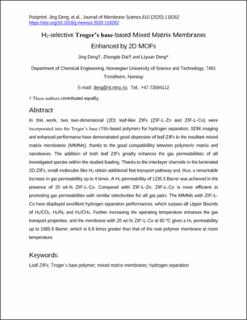| dc.contributor.author | Deng, Jing | |
| dc.contributor.author | Dai, Zhongde | |
| dc.contributor.author | Deng, Liyuan | |
| dc.date.accessioned | 2020-09-25T06:51:43Z | |
| dc.date.available | 2020-09-25T06:51:43Z | |
| dc.date.created | 2020-09-03T13:56:41Z | |
| dc.date.issued | 2020 | |
| dc.identifier.citation | Journal of Membrane Science. 2020, 610 118262-?. | en_US |
| dc.identifier.issn | 0376-7388 | |
| dc.identifier.uri | https://hdl.handle.net/11250/2679566 | |
| dc.description.abstract | In this work, two two-dimensional (2D) leaf ZIFs (ZIF-L-Zn and ZIF-L-Co) were incorporated into the Troger's base (TB)-based polymers for hydrogen separation. SEM imaging and enhanced performance have demonstrated good dispersion of leaf ZIFs in the resultant mixed matrix membranes (MMMs), thanks to the good compatibility between polymeric matrix and nanoleaves. The addition of both leaf ZIFs greatly enhances the gas permeabilities of all investigated species within the studied loading. Due to the interlayer channels in the laminated 2D ZIFs, small molecules like H2 obtain additional fast transport pathway and, thus, a remarkable increase in gas permeability up to 4 times. A H2 permeability of 1235.5 Barrer was achieved in the presence of 20 wt% ZIF-L-Co. Compared with ZIF-L-Zn, ZIF-L-Co is more efficient in promoting gas permeabilites with similar selectivities for all gas pairs. The MMMs with ZIF-L-Co have displayed excellent hydrogen separation performances, which surpass all Upper Bounds of H2/CO2, H2/N2 and H2/CH4. Further increasing the operating temperature enhances the gas transport properties, and the membrane with 20 wt% ZIF-L-Co at 60 °C gives a H2 permeability up to 1985.9 Barrer, which is 6.8 times greater than that of the neat polymer membrane at room temperature. | en_US |
| dc.language.iso | eng | en_US |
| dc.publisher | Elsevier | en_US |
| dc.rights | Attribution-NonCommercial-NoDerivatives 4.0 Internasjonal | * |
| dc.rights.uri | http://creativecommons.org/licenses/by-nc-nd/4.0/deed.no | * |
| dc.title | H-2-selective Troger's base polymer based mixed matrix membranes enhanced by 2D MOFs | en_US |
| dc.type | Peer reviewed | en_US |
| dc.type | Journal article | en_US |
| dc.description.version | acceptedVersion | en_US |
| dc.source.pagenumber | 118262-? | en_US |
| dc.source.volume | 610 | en_US |
| dc.source.journal | Journal of Membrane Science | en_US |
| dc.identifier.doi | 10.1016/j.memsci.2020.118262 | |
| dc.identifier.cristin | 1827091 | |
| dc.relation.project | Norges forskningsråd: 254791 | en_US |
| dc.description.localcode | © 2020. This is the authors’ accepted and refereed manuscript to the article. Locked until 24.5.2022 due to copyright restrictions. This manuscript version is made available under the CC-BY-NC-ND 4.0 license http://creativecommons.org/licenses/by-nc-nd/4.0/ " | en_US |
| cristin.ispublished | true | |
| cristin.fulltext | original | |
| cristin.fulltext | postprint | |
| cristin.qualitycode | 2 | |

